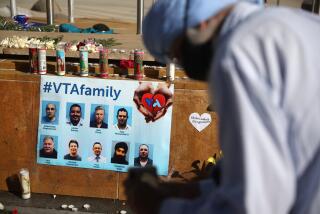U.S. Raises Penalties for Child Labor Safety Violations : Workplace: Employers now face multiple fines for an injury or death. The sanctions are announced amid a push for more summer jobs for teen-agers.
- Share via
WASHINGTON — In an effort to crack down on companies that subject teen-age employees to hazardous working conditions, the Labor Department on Thursday began enforcing stiffened penalties for child work safety law violations.
Under the new sanctions, employers that allow young workers to suffer serious injury or death can be fined $10,000 for each violation. Previously, negligent companies faced a $10,000 penalty for each accident. A single accident can involve multiple violations.
Child protection advocates said that many young workers are mistreated on the job. Hospital emergency rooms treated teen-agers for 64,000 job-related injuries in 1992, according to the National Institute for Occupational Safety and Health.
“As the school year draws to a close, teens across the country will be looking for work,” said Bernard Anderson, assistant labor secretary for employment standards. “They mean everything to us as parents and they are undeniably our country’s most valuable asset.”
As the penalties took effect Thursday, the Clinton Administration announced its plans to create more than 600,000 summer jobs for young people. Labor officials also urged private employers to hire 330,000 teen-agers for summer help.
More than 4 million children work in the United States in every industry from agriculture to manufacturing to food service. Frequently, teen-agers suffer burns and cuts while working at fast-food restaurants, become caught in agricultural machinery or are hit by cars while delivering newspapers, said Dr. Phillip J. Landrigan, a child specialist at Mt. Sinai Hospital in New York.
Work-related deaths are caused primarily by machinery, electrical accidents or falls, according to the National Child Labor Committee, a New York-based advocacy group. A NIOSH report on working youngsters found that 70% of deaths involved violations of federal child labor laws.
Studies show that older teen-agers are injured more frequently than young adolescents but that child injury is less prevalent than adult injury.
Labor Department officials said they expect the new policy to mean that more money will be collected in fines assessed in job-related injury cases. For example, if a 15-year-old is killed while operating a forklift in a warehouse, the Labor Department could dock the company once for violating rules against minors operating forklifts and again for breaking laws against 14- and 15-year-olds working in a warehouse.
A company could be fined $20,000 for such an accident under the new penalties but could have been charged with a maximum of $10,000 under the old system.
“The whole purpose is to deter violations,” said Art Kerschner, chief of the department’s child labor unit. “We don’t want to deter children’s employment.”
More stringent penalties probably will not prompt businesses to hire fewer children, said Dorianne Beyer, general counsel for National Child Labor Committee. “When employers need certain types of employees, for example those that can work part-time without benefits, they have no choice. They have to hire kids,” Beyer said.
Illegal child labor is the driving force behind “an underground economy” in the garment industry, said Jo-Ann Mort of the Amalgamated Clothing and Textile Workers Union in New York. “It’s so prevalent that you can go into the heart of the garment district and almost everywhere you look, there’s a sweatshop.”
New York state has a labor “SWAT team” that storms into suspected sweatshops and searches for safety violations. Investigators have turned up serious safety violations and in one sweatshop found children who had lost fingers while operating a machine used to make leather belts.
In Los Angeles, child workers are most often injured using meat-slicing machines, dough mixers and in occupations that involve driving, a Labor Department spokeswoman said.
Working Children
A U.S. Labor Department study at six Los Angeles high schools found:
50% of 14- and 15- year-olds in violation of laws barring companies from working them past 7 p.m. during the school year.
15% of 14- and 15-year-olds in violation of laws barring companies from employing them in construction jobs.
5% of 16- and 17-year-olds in violation of laws barring companies from employing them to use meat-slicing or dough-making equipment.
Why They Work
To buy clothes, cars, other goods 74%
Required to contribute to family income 25%
Source: Labor Department Wage and Hour Division study of 204 students, in April, 1991
More to Read
Sign up for Essential California
The most important California stories and recommendations in your inbox every morning.
You may occasionally receive promotional content from the Los Angeles Times.













